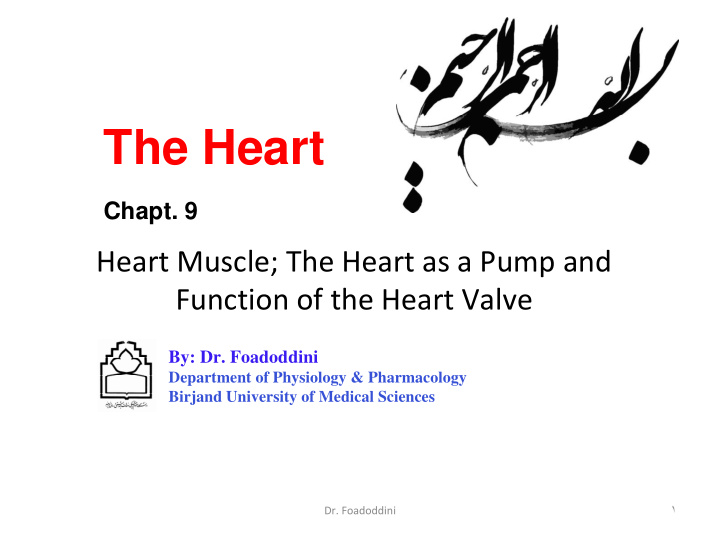



The Heart Chapt. 9 Heart Muscle; The Heart as a Pump and Function of the Heart Valve By: Dr. Foadoddini Department of Physiology & Pharmacology Birjand University of Medical Sciences ١ Dr. Foadoddini
٢ Dr. Foadoddini
Electrical Activity of the Heart • Ion channels: – They are selective – A given ion may have several different channel ٣ Dr. Foadoddini
٤ Dr. Foadoddini
٥ Dr. Foadoddini
٦ Dr. Foadoddini
Excitation-contraction coupling ٧ Dr. Foadoddini
Electrical Activity of the Heart • Maintenance of Ionic Gradient: – Digitalis inhibit Na ‐ K pump – = 2×10 ‐ 3 and [Ca] i = 10 ‐ 7 [Ca] o – 10 ‐ 5 M – Na ‐ Ca Exchanger can operate in either direction (depend upon the membrane potential) – Decreased Na ‐ K ATPase activity increase intracellular Na and Ca ٨ ٨ Dr. Foadoddini
٩ Dr. Foadoddini
١٠ Dr. Foadoddini
Intercalated disck Functional Syncytium ١١ Dr. Foadoddini
١٢ Dr. Foadoddini
١٣ Dr. Foadoddini
Electrical Activity of the Heart • In non-pacemaker cells Action potential: I to ↓ I K (Inward rectifier) ↑ I K (Delayed rectifier) The long ERP prevent the heart developing sustained, tetanic contraction These potentials are so called ‘ Fast Response’ action potential because of rapid phase 0 depolarization ١٤ ١٤ Dr. Foadoddini
١٥ Dr. Foadoddini
Cardiac valves One way path Passive opening/closing Diameter diffferences Cordae tendineae ١٦ Dr. Foadoddini
Volume-pressure curves as heart work Area under curve as cardiac external work ١٧ Dr. Foadoddini
Cardiac cycle Pressure ‐ volume relationship 1. ABC: Ventricular Diastole 2. CD: Isovolumic contraction. 3. DF: Ventricular Systole 4. DE: Ejection (Rapid and reduced ejection) 5. FA: Isovolumic relaxation 6. ABC: Filling phase (Rapid filling and diastases) Atrial systole ١٨ Dr. Foadoddini
CO End-diastolic pressure Venous return/Atrial pressure ١٩ Dr. Foadoddini
٢٠ Dr. Foadoddini
Frank-Starling mechanism ٢١ Dr. Foadoddini
٢٢ Dr. Foadoddini
٢٣ Dr. Foadoddini
Arterial pressure ٢٤ Dr. Foadoddini
٢٥ Dr. Foadoddini
Chapt. 10 Rhythmical Excitation of the Heart ٢٦ Dr. Foadoddini
٢٧ Dr. Foadoddini
٢٨ Dr. Foadoddini
Electrical Activity of the Heart • Action potential: In pacemaker cells ↑ I K (Delayed rectifier) – They are in SA and AV node – They do not have a true resting potential – Fast Na channels are in activated – They induces Overdrive suppression T-type Ca current •These potentials are so called ‘ Slow Response’ action potential because of slow phase 0 depolarization •Sometimes Fast Responses are converted to the Slow Responses ٢٩ Dr. Foadoddini
٣٠ Dr. Foadoddini
Stokes-Aadams syndrome (after A-V block) ٣١ Dr. Foadoddini
Electrical Activity of the Heart Neuronal mechanisms that alter pace-maker activity Ventricular escape Normal range = 100 to 110 beats/min 60 beats/min to over 200 beats/min • At resting heart, vagal influences are dominant over sympathetic (vagal tone) • Change in heart rate = Chronotropy • Change in contraction = Inotropy • Change in conduction velocity = Dromotropy ٣٢ Dr. Foadoddini
٣٣ Dr. Foadoddini
Recommend
More recommend